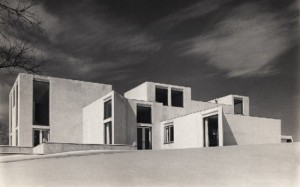
In April 1970 the Historical Society of Chestnut Hill, an old garden suburb of Philadelphia, organized a public panel to discuss the future of their community. The venue had to be changed to accommodate the 800 people who showed up. I suspect that the audience, which included many students, was drawn less by the subject than by the panelists: Louis Kahn, Robert Venturi, and Romaldo Giurgola. The local newspaper referred to them as “three of America’s foremost architects” and “today’s pacesetters.” Kahn was already a national figure; Venturi had built little and was probably best known for Complexity and Contradiction in Architecture, published in 1966, although the house that he had recently designed for his mother had caused ripples in the architectural world; Giurgola was head of Columbia’s department of architecture and his architectural career was taking off, he had just designed the American embassy in Bogotá. All three had built houses in Chestnut Hill: Kahn the Margaret Esherick house, a little gem; Venturi the Vanna Venturi House, his mother’s house; and Giurgola the Dorothy White House. By curious coincidence all three houses were for single women.
Almost fifty years later the reputations of the “pacesetters” have taken different courses. That of Kahn, who died only four years after the Chestnut Hill panel, has, if anything, grown; his place in history is secure. Venturi’s reputation is harder to assess. Few later projects lived up to the promise of his mother’s house (my favorite is the Sainsbury Wing of the National Gallery in London), and the demise of postmodernism didn’t help, despite the architect’s vain attempt to disassociate himself from that movement. Giurgola received the AIA Gold Medal in 1982, but a well-intentioned effort to expand Kahn’s Kimbell Art Museum savaged his reputation and he ended up moving to Australia, where he had won a competition to design Parliament House in the national capital. Like Harry Seidler before him, he seems destined to be remembered—if he is remembered at all—as a purely regional star.
Kahn, Venturi and Giurgola are sometime lumped together as belonging to the “Philadelphia School.” That is hyperbole—they were very different sorts of architects. It is said that at the dinner after the Chestnut Hill panel, they hardly spoke to each other. Still, it would have been interesting to be a fly on the wall.

When Giurgola died on 16 May, one Sydney newspaper described him as “renowned and revered”. His Australian Parliament House in Canberra (he designed the building, not the city) seems to me terribly underrated. It should be seen as one of the world’s great buildings.
I’ve worked in and visited it many times over the years, and am always knocked sideways by how well it does its jobs, from the chambers, to the executive offices, to the public areas, to the iconic simplicity of the external forms. The symbolism of a Parliament which people can walk on top of is pretty much perfect.
I think it was the Canadian commentator Mark Steyn who said that the building changed his mind about the possibility of having a piece of modern architecture transmit dignity and authority.
And after all that, it’s simply beautiful in a startling number of different ways. He was very welcome in Canberra and rightly took great pride in what he had wrought. No wonder. If I’d built something that significant and that good, I’d want to look at it every day for the rest of my life too.